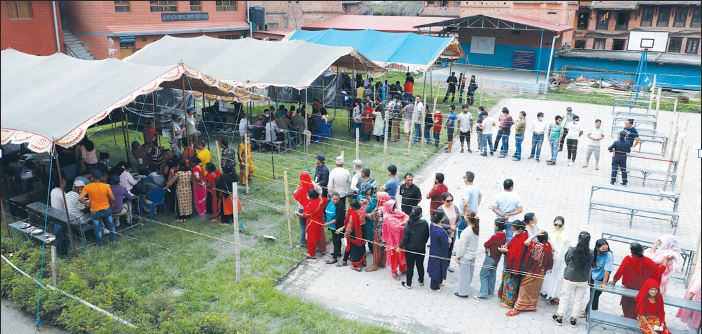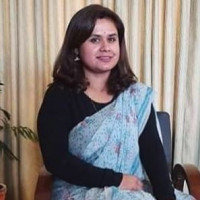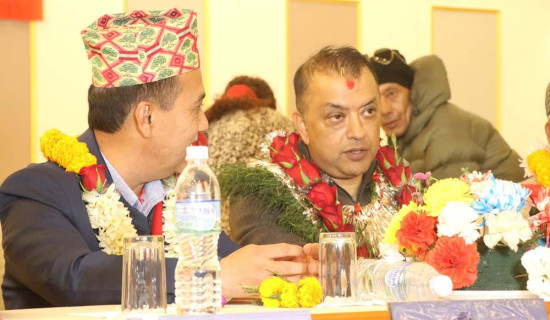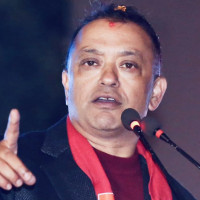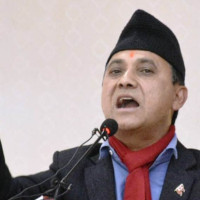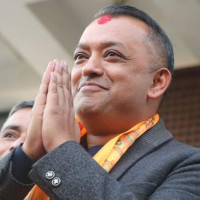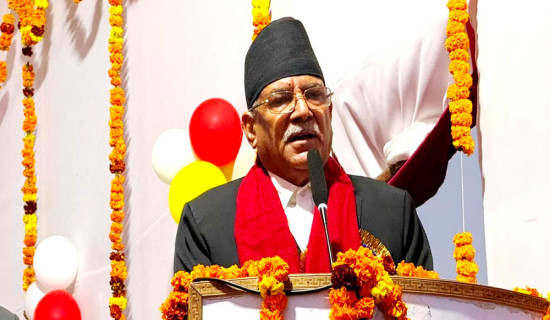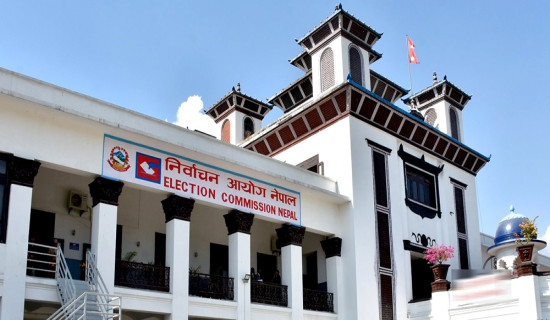- Saturday, 17 January 2026
Local elections indicate changing trend among voters
Kathmandu, May 15: The country on Friday successfully conducted local level elections nationwide. This local polls is the second of its kind after the country adopted a federal republic system following promulgation of a new Constitution in 2015.
The local polls were largely peaceful except for few reports of clashes amid tight security. People throughout the country, including as old as 113-year-old voter, enthusiastically participated in the polls to elect 35,211 representatives of their choice for 753 local units from 145,011 candidates.
The local polls will elect 586 mayors and deputy mayors in municipalities, 920 chairs and vice chairs in rural municipalities and 33,715 office bearers will be elected in 6,743 wards. Vote counting in many places has already started from Friday itself, while some have started from the Saturday morning. Nepali Congress (NC) has been leading in the majority of the places.
Voters’ turnout down
The Election Commission has said that voters’ turnout in the polls was not as expected. The turnout this year was 64 per cent compared with 72.5 in the 2017 polls – a drop by 8.5 percent. Similarly, Kathmandu district has recorded only 52 per cent turnout.
Assistant Spokesperson Shaligram Sharma Poudel said, “The recent data received from the district election offices shows that the voter’s turnout of local poll has reached around 70 per cent. However, the data provided by Nepal Police shows the turnout is less.”
A total of 17,733,723 voters were eligible to cast their votes.
Chief Election Commissioner Dinesh Kumar Thapaliya said on Friday that the commission was not happy with the turnout, as it was less than what they had estimated. The EC had earlier estimated the turnout of 65 to 70 per cent.
He said the turnout was not satisfactory and blamed the 52 per cent turnout in Kathmandu, which has the highest numbers of voters (637,775) for the overall poor participation of voters.
Why large number of people abstained?
Widespread disappointment with politicians and parties is one reason given by political observers.
“The low number of voters indicates that there is a general disillusionment among the ordinary voters with the contesting parties,’’ said Pradip Pokharel, chairman of Election Observation Committee (EOC) Nepal.
Former Chief Election Commissioner Ayodhi Prasad Yadav said, “The extended irregularities in the local bodies, people’s representatives being more money-minded, increasing numbers of political parties and candidates, among other reasons, discouraged the voters from taking part in the electoral process.”
“Unfulfilled past populist promises have also lowered values of the political parties and leaders, and there has been a disconnection between politicians and the people,” he added.
Yadav also blamed the EC for not creating enough awareness to encourage more voters to vote. Experts are also citing migration as one of the reasons for the low turnout.
EOC chairman Pokharel said, “Though the voters’ turnout seems to have fallen compared to the last election, the existing number of the voters should be considered while understanding the actual turnout.
Pokharel, who has been observing elections in Morang and Sunsari, shared that very few numbers of new voters have participated in the polling process. “Migration of a large number of young populations for studies or jobs abroad might have also contributed to the relatively lower number of voters. In the same way, around 500,000 voters, including election staff and security personnel, were also deprived of voting,” he said.
“Similarly, a significant section of the young population has little interest in politics and voting. They consider politics a dirty game, which might have prompted them to stay away from voting,” said Pokharel. He said, “There is a need to conduct studies to understand the reasons for the low turnout so that it can be improved in the federal and provincial elections.”
When asked how he compares the previous local polls with the recent one, Yadav said, to compare the elections, one had to understand the situation, availability of time and challenges.
According to him, holding elections in 2017 was much challenging compared to this local poll because there was a big challenge in implementing the Constitution, which was opposed by the Madhesi people, and convincing them to participate in the polls.
There were also time limits, said Yadav, adding, “Despite all these challenges, the local poll was held successfully five years ago, with around 74 per cent voter turnout.”
He pointed out lapses in security arrangements, election management and voters’ education in this election. “However, holding periodic elections despite all the constraints is an intrinsically desirable goal and good democratic practice,” he said.
However, EOC chairman Pokharel said this local poll was held in a largely peaceful manner compared to the previous one because there are less human casualties in this election than in the past. Commenting on the violent activities reported in several places, he said, “This is also the characteristic of the South Asian countries. This is the second election after the country adopted a federal republic system. The situation will gradually improve.
Poll canceled in 79 polling centres of 28 local bodies
Sporadic violent activities were reported in some places during the local level election. Police had to use force because of unwanted incidents in a few places.Subsequently, polls for at least 79 polling centres of 20 local bodies of 15 districts were canceled following the violence and disputes. The date for the election in those places would be announced soon, the EC said in its statement.
EC’s Spokesperson Poudel said that the number could be further high since the EC had received complaint from polling centres of some municipalities of Ilam, Tanahun and other districts.
According to EC, voting has been cancelled at 32 polling centres of Sudurpaschim Province, including 20 polling centres of Budhiganga Municipality of Bajura.
Likewise, voting has to be canceled in 29 polling centres of Madhesh Pradesh, including 20 polling centres of four municipalities of Rautahat district.
Voting has to be postponed as general disputes escalated in most of the polling stations. The EC has said that such a situation is unfortunate.
Chief Election Commissioner Dinesh Kumar Thapaliya has admitted that there was a problem in the security arrangements, as the election was conducted in a single phase. A lack of needed cooperation from the political parties and candidates were also blamed for the violent activities in the polling process. However, EOC chairman Pokharel said holding re-election is better than causing human casualties.
The commission had set up 10,756 polling stations and 21,955 voting booths across the country for the polls. The government had deployed 265, 000 security personnel across the country in all, including 100,000 temporary police, for the election security.
65 political parties participated in the local polls
According to the EC, as many as 79 political parties have registered themselves to contest elections at the local level, out of which only 65 parties have contested in the local polls.
In this election, the major competition is between the five-party ruling alliance and the main opposition CPN-UML. The five ruling parties, the NC, the CPN (Maoist Centre), the CPN (Unified Socialist), Janata Samajwadi Party and Rastriya Janamorcha Party, have formed an electoral alliance, against the main opposition, the CPN-UML.
The UML has also joined hands with some fringe parties like Rastriya Prajatantra Party, Nepal Pariwar Dal and Loktantrik Samajwadi Party.
The ruling coalition parties have reached a deal on seat-sharing in six metropolitan cities and 11 sub-metropolitan cities. However, the coalition failed to maintain alliance in lower rungs, after they witnessed rebel candidates, who defied the instructions of the topmost leaders of their parties.
The NC, the CPN-UML and the CPN (Maoist Centre) seem to dominate the political landscape as the three major parties even in the local level election. Considering the latest polls counting, the big three parties are likely to gain the status of three major political parties.
Confusing ballot paper design
Experts are worried that the number of invalid votes might be high due to a jumbo ballot paper and confusion over the candidates of the ruling alliance.
The EC had printed two types of ballot papers for the local elections. One-page ballot papers are being used in 36 districts while the remaining will have two-page ballot papers.
Voters have said they found it hard to grasp how to vote for two open category ward members in the final columns as a single symbol is assigned to one candidate and double to others. Puspa Sharma, a voter of Ward No. 4 KMC, said due to the same confusion she mistakenly marked three members in the final columns.EOC chairman Pokharel said, “The EC’s decision to impart voters’ education just two days before the polling day was very impractical.”
In the last five years EC should have continued to educate voters, he said, adding, “The EC could also make the ballot papers simple, if they had waited until the candidates withdrew their candidacy.”
Further, the electoral alliance also makes the ballot paper confusing, making it difficult for voters to find poll symbols and correctly cast the votes.

